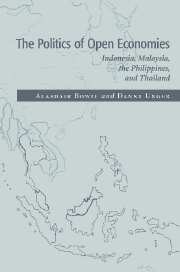1 - Introduction
Published online by Cambridge University Press: 10 November 2009
Summary
This book attempts to explain why some developing countries adopt economic policies that are relatively open to cross-border movements of goods, services, and capital. In particular, it focuses on national economic policy responses to changing external economic conditions and asks what factors account for the propensity of some countries to maintain or increase their economic openness while others opt to reduce it. The analysis is limited to the economic policies of four Southeast Asian states – Indonesia, Malaysia, the Philippines, and Thailand (the ASEAN four) – during the half-century following the end of the Pacific War.
Indonesia, Malaysia, the Philippines, and Thailand are, along with Vietnam, the most populous members of ASEAN. Unlike Vietnam, they have chosen market-oriented development strategies since they gained independence (Thailand never was colonized). As a group, their economic performance has been very strong over the last thirty years (see table 1.1). While the Philippines stands out within this group as a laggard, its record, when measured against the entire population of developing economies, has been at least average (see table 1.2). For these and other reasons (explained below), we have chosen to use these four countries to understand better those factors that lead officials in developing countries to maintain or adopt open economic policies.
Our interest in developing countries' open economic policies stems in considerable part from the relative rareness of such policies before the 1980s.
- Type
- Chapter
- Information
- The Politics of Open EconomiesIndonesia, Malaysia, the Philippines, and Thailand, pp. 1 - 24Publisher: Cambridge University PressPrint publication year: 1997

